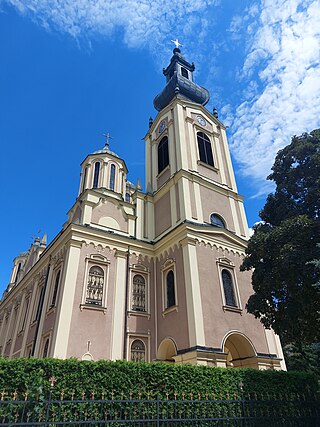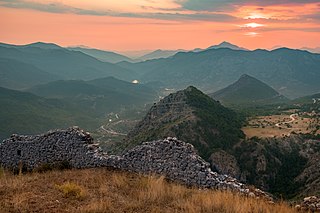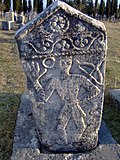
Zenica is a city in Bosnia and Herzegovina and an administrative and economic center of the Federation of Bosnia and Herzegovina's Zenica-Doboj Canton. It is located in the Bosna river valley, about 70 km (43 mi) north of Sarajevo. The city is known for its Ironworks Zenica factory but also as a significant university center. According to the 2013 census, the settlement of Zenica itself counts 70,553 citizens and the administrative area 110,663, making it the nation's fourth-largest city.

Visoko is a city located in the Zenica-Doboj Canton of the Federation of Bosnia and Herzegovina, an entity of Bosnia and Herzegovina. As of 2013, the municipality had a population of 39,938 inhabitants with 11,205 living in Visoko town. Located between Zenica and Sarajevo, Visoko lies where the river Fojnica joins the Bosna.

Tourism in Bosnia and Herzegovina is a fast-growing sector making up an important part in the economy of the country.

The Cathedral Church of the Nativity of the Theotokos is the largest Serbian Orthodox church in Sarajevo and one of the largest in the Balkans. The cathedral is designated National Monument of Bosnia and Herzegovina by the KONS.
Blace is a village in the municipality of Konjic, Bosnia and Herzegovina.

Blagaj Fortress or Old Town of Blagaj, locally known as Stjepan-grad (Стјепан-град), or Stipan-grad, in classical times Bona (Бона), is a town-fortress complex near the town of Blagaj, Bosnia and Herzegovina. The old Blagaj Fort was built on a high, inaccessible karst hill, at an elevation of 310 metres (1,020 ft) above sea level and 266 metres (873 ft) above the source of the river Buna. Blagaj Fort is 275 metres (902 ft) above sea level. Fortress is National monument of Bosnia and Herzegovina, declared by KONS on 6 December 2003.

The Miloradović or later Stjepanović (Стјепановић), whose paternal parent house was Hrabren (Храбрен), were an Eastern Orthodox Bosnian Vlach noble family and a katun clan from Hum, and later Sanjak of Herzegovina, parts of present-day Bosnia and Herzegovina, and whose some later branches embraced the Bosnian Serb ethnic identity, while others converted to Islam and became Bosnian Muslims. The members of the family served the Kingdom of Bosnia, the Republic of Ragusa, and the Ottoman Empire. One branch of the Miloradović's established themselves as military leaders of Russian Empire and were adopted into the Russian nobility. The family left behind several cultural-historical monuments important to Bosnian and Herzegovinian heritage, protected as such by the KONS state agency and the UNESCO.

Muslihudin Čekrekčija Mosque, also known as Čaršijska, is second oldest domed mosque in Sarajevo. It was constructed in 1526 in the Baščaršija area of the city, at the foot of Kovač. It is raised in the mahala of Isa-Bey's turn. From the vakufnam of the founder of the mosque, Hajji Mustafa, the son of Ishak, is known to the people as Muslihudin Čekrekčija, her builder. This is also the oldest known original document written in Sarajevo.

Vratnik, also known as Stari grad Vratnik, is one of the oldest neighbourhoods in Sarajevo, and Bosnia and Herzegovina.

Central Bosnia is a central subregion of Bosnia, which consists of a core mountainous area with several basins, valleys and mountains. It is bordered by Bosnian Krajina to the northwest, Tropolje to the west, Herzegovina to the south, Sarajevo to the east and Tuzla to the northeast. It is a part of the Federation of Bosnia and Herzegovina and is divided between the Central Bosnia Canton and the Zenica-Doboj Canton, with a population of around 800,000. The largest city in the region is Zenica, with the Sarajevo-Zenica basin being the most densely populated area. Its highest peaks are Vranica, Šćit and Bitovnja.

Mehmed Pasha Kukavica Mosque was one of five mosques in Foča town, in Bosnia and Herzegovina which typologically belonged to a single-space domed mosque with an open exterior portico. It was located in Gornja (Upper) čaršija, and completely destroyed during the Bosnian War. Built in 1751, it was a part of an architectural ensemble consisting of the mosque, madrasa, clock tower and hammam, all endowments of Foča-born Mehmed-paša Kukavica, one of the most prominent Ottoman governors of Bosnia.

The Commission to Preserve National Monuments of Bosnia and Herzegovina, abbr. KONS, is Bosnia and Herzegovina commission (agency) which declares and registers national heritage monuments/sites, including natural/urban/architectural assembles, immovable and movable heritage of historical and cultural importance to Bosnia and Herzegovina, as an institution at state level. The sites of exclusively natural heritage are not subject of Annex 8 and the KONS.

Travnik Castle, locally known as Stari Grad Castle, is a medieval town-fortress complex in the town of Travnik, Central Bosnia Canton, Bosnia and Herzegovina.

The Walled city of Vratnik, also Old Vratnik Fort, is located in Vratnik neighborhood, in Sarajevo, Bosnia and Herzegovina. It represents urban core within the wider neighbourhood of the same name. Since 2005 the KONS designated walled area of the neighborhood a national monument of Bosnia and Herzegovina.

Klobuk is a medieval fortress in Bosnia and Herzegovina. It is located on the karst plateau of Mirotinske grede, near the village of Klobuk, Trebinje, in the Republic of Srpska entity of Bosnia and Herzegovina. It is declared a National Monument of Bosnia and Herzegovina, by the Commission to Preserve National Monuments of Bosnia and Herzegovina.

Kraljeva Sutjeska is a village in the municipality of Kakanj, Bosnia and Herzegovina. The village has historical significance and rich heritage, and during the Middle Ages it used to be a capital of medieval Bosnian state.



























